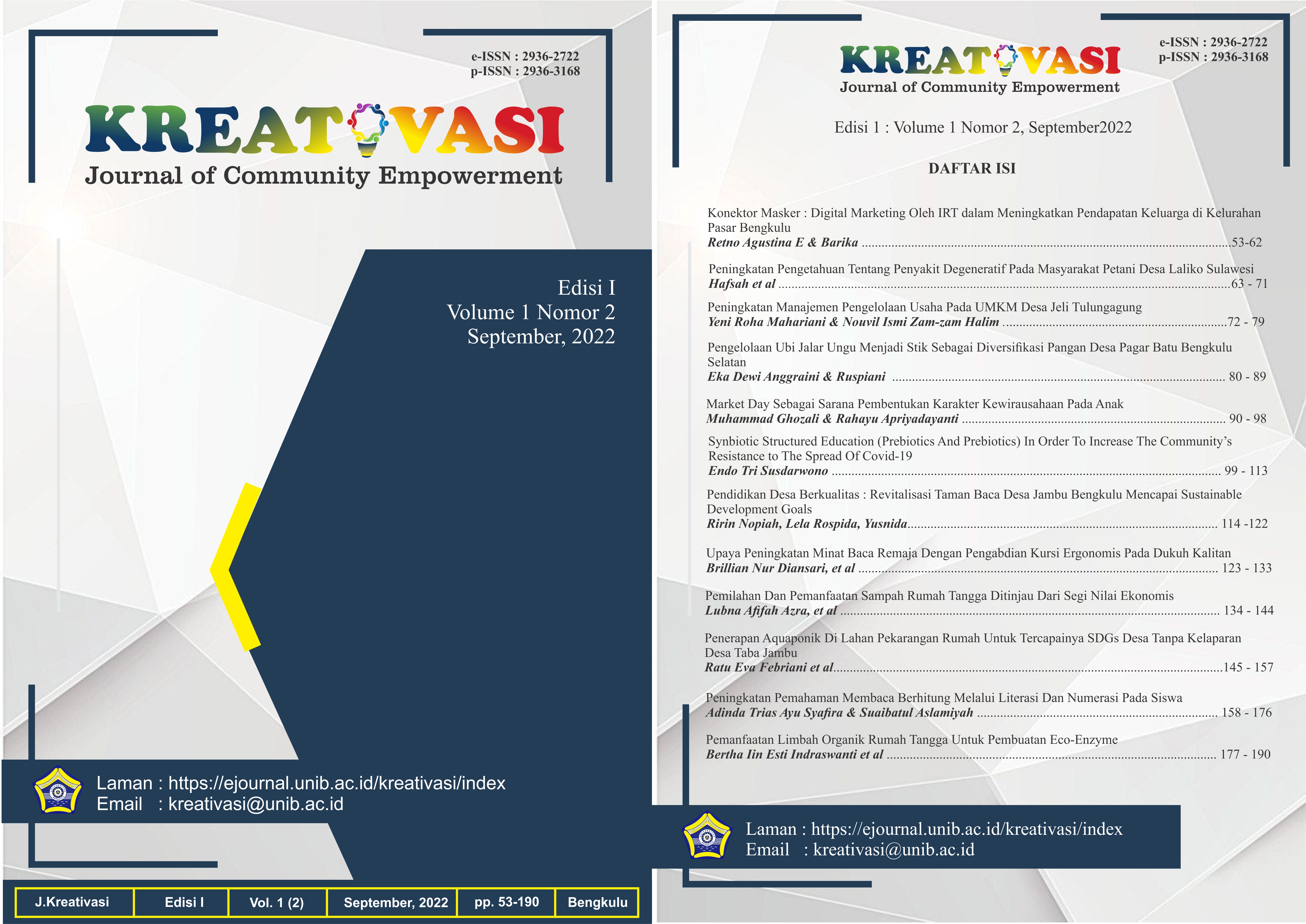Main Article Content
Abstract
The development of science and technology that is increasing rapidly at the time causes the development of information to grow rapidly. Dukuh Kalitan is one area that has a young generation with low interest in reading. One of the reasons for this lack of interest in reading is the lack of education about the importance of reading for the younger generation. Another factor is found in the field is the unavailability of reading facilities in Dukuh Kalitan. The solution offered from these problems is the procurement of an ergonomic reading chair. The reading chair will be made based on the user’s body dimensions. The goal is to make users feel comfortable, prevent risks that occur due to workloads, and increase user satisfaction. The method used through a combination of empowerment includes methods: increasing knowledge in the form of counseling and procuring products in the form of an ergonomic reading chair. The procurement of ergonomic reading chairs is carried out by measuring the user’s body dimensions using anthropometry and percentile calculations. The design of this ergonomic reading chair uses a design type for adjustable use. The conclusions that can be drawn are as follows: (1) the principle of ergonomics is very relevant in designing an ergonomic reading chair that fits the dimensions of the user’s body; (2) there are 7 dimensions for designing an ergonomic reading chair for teenagers in Dukuh Kalitan, namely: popliteal height, popliteal buttocks, hip width, sitting shoulder height, shoulder width, sitting elbow height and forearm length.
Keywords
Article Details
Copyright (c) 2022 Brillian Nur Diansari, Muhammad Syarqim Mahfudz, Fertilio Dwyanton, Muhammad Abdul Majid

This work is licensed under a Creative Commons Attribution-ShareAlike 4.0 International License.
- This statement is a commitment from the author, to respect copyright, both in terms of quoting the work of others, as well as in the use of journal content.
- If needed, the author can send a statement of authenticity of the manuscript. With the receipt of an article by the Editor of Kreativasi - Journal of Community Empowerment, the article submitted has the copyright held by Kreativasi - Journal of Community Empowerment:
- Kreativasi - Journal of Community Empowerment has the right to reproduce and distribute articles that have been published in journals.
- The author is not permitted to publish the same article that has been published in this journal.
References
- Andhini, Vrilly. (2018). Hubungan Antropometri Dengan Kursi Kerja di Kantor Pelayanan Perbendaharaan Negara Mojokerto. Journal of Occupational Safety and Health, Vol.7(2), p.200-209. https://doi.org/10.20473/ijosh.v7i2.2018.200-209
- Anisa, dkk. (2021). Pengaruh Kurangnya Literasi serta Kemampuan dalam Berpikir Kritis yang Masih Rendah dalam Pendidikan di Indonesia. 1st National Conference on Education, System and Technology Information, Vol.01(01), p.1-12.
- Biomi, A. A. dan Dharmayanti, C. I. (2021). Meja dan Kursi Belajar Ergonomis Mengurangi Keluhan Muskuloskeletal Siswa SMP Tunas Daud di Denpasar. Jurnal Ergonomi Indonesia (The Indonesian Journal of Ergonomic), Vol.7(2), p.129-134.
- Iridiastadi, H. (2014). Ergonomi Suatu Pengantar : PT. Remaja Rosdakarya.
- Manuaba, A. (2004). Kontribusi Ergonomi dalam Pembangunan, dengan Acuan Khusus Bali. 2nd National Seminar on Ergonomics, Vol.9.
- Purnomo, Hari. (2004). Pengantar Teknik Industri : Graha Ilmu.
- Roebuck, Jr. (1995). Antrhropometric Methods: Designing to Fit the Human Body : Human Factors and Ergonomics Society.
- Wahyuni, dkk. (2014). Sikap Duduk Ergonomis Mengurangi Nyeri Punggung Bawah Non Spesifik pada Mahasiswa Program Studi Fisioterapi Fakultas Kedokteran Universitas Udayana. Majalah Ilmiah Fisioterapi Indonesia, Vol. 2 No. 1.
- Wignjosoebroto, S. (2000). Evaluasi Ergonomis Dalam Proses Perancangan Produk. Proceeding Seminar Nasional Ergonomi.
- Yassierli, dkk. (2020). Panduan Ergonomi “Working From Home” : Perhimpunan Ergonomi Indonesia.
References
Andhini, Vrilly. (2018). Hubungan Antropometri Dengan Kursi Kerja di Kantor Pelayanan Perbendaharaan Negara Mojokerto. Journal of Occupational Safety and Health, Vol.7(2), p.200-209. https://doi.org/10.20473/ijosh.v7i2.2018.200-209
Anisa, dkk. (2021). Pengaruh Kurangnya Literasi serta Kemampuan dalam Berpikir Kritis yang Masih Rendah dalam Pendidikan di Indonesia. 1st National Conference on Education, System and Technology Information, Vol.01(01), p.1-12.
Biomi, A. A. dan Dharmayanti, C. I. (2021). Meja dan Kursi Belajar Ergonomis Mengurangi Keluhan Muskuloskeletal Siswa SMP Tunas Daud di Denpasar. Jurnal Ergonomi Indonesia (The Indonesian Journal of Ergonomic), Vol.7(2), p.129-134.
Iridiastadi, H. (2014). Ergonomi Suatu Pengantar : PT. Remaja Rosdakarya.
Manuaba, A. (2004). Kontribusi Ergonomi dalam Pembangunan, dengan Acuan Khusus Bali. 2nd National Seminar on Ergonomics, Vol.9.
Purnomo, Hari. (2004). Pengantar Teknik Industri : Graha Ilmu.
Roebuck, Jr. (1995). Antrhropometric Methods: Designing to Fit the Human Body : Human Factors and Ergonomics Society.
Wahyuni, dkk. (2014). Sikap Duduk Ergonomis Mengurangi Nyeri Punggung Bawah Non Spesifik pada Mahasiswa Program Studi Fisioterapi Fakultas Kedokteran Universitas Udayana. Majalah Ilmiah Fisioterapi Indonesia, Vol. 2 No. 1.
Wignjosoebroto, S. (2000). Evaluasi Ergonomis Dalam Proses Perancangan Produk. Proceeding Seminar Nasional Ergonomi.
Yassierli, dkk. (2020). Panduan Ergonomi “Working From Home” : Perhimpunan Ergonomi Indonesia.
